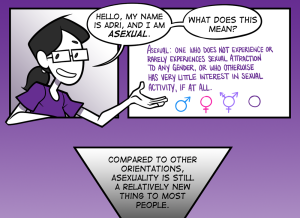Speaker 1: My mom’s Puerto Rican. That’s why I’m so lively and colorful.
Cristen: Latinas in pop culture are often stereotyped as curvaceous, passionate, loud, tempestuous, super Catholic, really good cooks, and wild in the bedroom. Think Eva Longoria on Desperate Housewives, Sofía Vergara on Modern Family, and Naya Rivera on Glee. In other words, just think “spicy.”
What’s so wrong with using one convenient adjective to describe a massive group of women? Because, after all, Sofia Vergara is hilarious when she makes those Modern Family jokes or she mispronounces words.
Speaker 3: You try speaking in another language. Everybody out of my house!
Cristen: I love spicy food. I mean, I have like five hot sauces in fridge. That also isn’t a lie, but what these fiery, hot, and spicy stereotypes are really doing is marginalizing Latinas into objects for consumption with hot-tempered brains not to be taken seriously, and hypersexualized bodies that are anyone’s buffet.
Just imagine how that must feel.
Are you legitimately upset about something? Did you just voice a valid opinion? Do someone find you attractive? Oh, you’re so spicy.
Why does this spicy Latina stereotype happen? How did we manage to collapse women hailing from 21 different countries, and heritages, and cultures, and even skin tones, from tip-top of Mexico all the way down to the bottom of Chile and across the Caribbean, down to one puny pepper? No offense, jalapeño.
Ingredient number one: old school racism.
Speaker 4: Not every Hispanic person wants the same thing.
Speaker 5: Oh, sure they do. They all want to come to America.
Cristen: Let’s hog back to the mid-19th century, which was a pretty terrible no good time for Latinos in the US due to things like the Mexican-American War, California Gold Rush, and the Treaty of Guadalupe Hidalgo, which fostered anti-Mexican sentiment and outright racism.
Between 1848 and 1928, there were 547 documented Mexican lynchings in the American Southwest. On July 5th, 1851, Juana Loaiza became the first and only woman ever lynched in California after she stabbed to death a white man who, along with a group of men, broke into her home and attempted to rape her. Although married and fending off a group assault, since she was Mexican, the press deemed her promiscuous and not worthy of saving.
We see evidence of this racism in early Hollywood films that portrayed Latinos as lazy, dim-witted, or dangerous, and Latinas as little more than morally bankrupt, tempestuous seductresses like Dolores del Río and Lupe Vélez, who was described by an old school tabloid as, “Just a wild Mexican kitten.” The Mexican government became so fed up with these derogatory portrayals that it issued an embargo on offensive Hollywood films in 1922.
Spicy ingredient number two: cartoonization or, trade that pepper for a banana. In the 1930s, the spicy stereotype got a colorful makeover courtesy of the US government.
Inspired by FDR’s Good Neighbor policy, tropicalism portrayed Latinos as festive, exotic, and diplomatically harmless, embodied by the wildly popular performer Carmen Miranda, whose native Brazilians resented her caricaturing for American audiences. The lady in the tutti-frutti hat, as Miranda became known, perfected the Mexican spitfire trope, which blended dashes of sexuality and comedy with the requisite spice and broken English.
Speaker 6: (Clip of Carmen Miranda singing)
Cristen: This tropicalism treatment also outfitted these always brunette Latina characters with signature red lips, bold jewelry, and curve-hugging clothes that emphasized their breasts and hips.
Ring ring. Hello? Sound familiar?
Spicy stereotype ingredient number three: marginalization or, if a stock character ain’t broke, don’t fix it!
Fast forward to 2010 to 2013, and 9.1% of Latinas on television were portraying the sexy spitfire.
Speaker 3: I knew it!!
Cristen: From the big screen, an analysis of the 100 top grossing films from 2007 to 2013 found that Latinas were the likeliest group of women to be shown partially or fully naked. But during this time, one Latino stock character on television actually outpaced the sexy spitfire and that is the sassy maid, with Latinas playing 69% of them.
And that kind of persistent type casting, which feeds into the spicy stereotype …
Speaker 7: Will you guys stop doing that?
Cristen: … is part of what led Gina Rodriguez to turn down an offered role on Devious Maids before she became Jane the Virgin. Speaking about that potentially risky decision, the now Emmy-winning Rodriguez, whose parents are Puerto Rican, perfectly summed up why this kind of stereotype-busting is so important, not just on television and in movies, but in the real world:
I wanted it to be a story that was going to liberate young girls and say, ‘Wow, there we are too, and we’re the doctors, and we’re the teachers, and we’re the writers, and we’re the lawyers, and I can do that, too.'”
What do those professions have in common? No spice needed because Latinas aren’t peppers. They’re people.



















